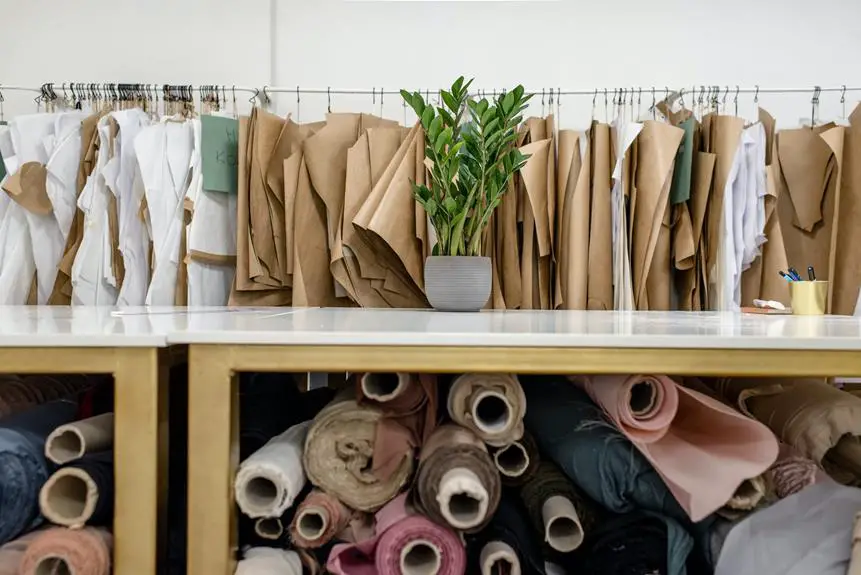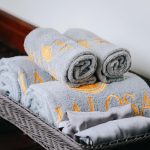When you envision the perfect fabric for your next project, have you considered its width? Understanding the common fabric widths can make all the difference in your crafting endeavors.
From the standard 45-inch width to the expansive 120-inch width, each option offers unique possibilities for your designs.
In this guide, you'll explore the various fabric widths, equipping you with the knowledge to select the perfect material for your next creation. Whether you're a seasoned seamstress or a budding crafter, mastering fabric widths is an essential skill that allows you to bring your visions to life with precision and expertise.
Key Takeaways
- Standard fabric widths include 45-inch, 60-inch, 72-inch, 90-inch, and 108-inch options.
- Wide fabric widths provide ample fabric to work with and are versatile for various projects such as garments, home decor, quilting, and crafting.
- Extra-wide fabric widths, such as 108-inch and 120-inch options, eliminate the need for piecing together multiple sections of fabric and create a seamless overall appearance.
- Understanding fabric widths is important for accurate project planning, determining the amount of fabric needed, and maximizing sewing efficiency.
Standard 45-Inch Width
Do you frequently use fabric with a standard 45-inch width for your sewing projects?
When it comes to standard fabric widths, the 45-inch option is a popular choice among sewers and crafters. This width is versatile and commonly used for a wide range of projects, making it a go-to option for many.
When it comes to fabric selection, the 45-inch width offers a good balance between usability and efficiency. It's wide enough to accommodate various garment patterns, making it suitable for sewing clothing, accessories, and household items. Additionally, this standard width is often readily available at fabric stores, providing ample choices for colors, patterns, and fabric types.
Whether you're a beginner or an experienced seamstress, having a good supply of 45-inch wide fabric in your stash is essential for tackling diverse sewing endeavors. As you continue to hone your sewing skills, understanding the benefits and versatility of this standard fabric width will enhance your fabric selection process and empower you to take on a wide array of creative projects.
60-Inch Width
When shopping for fabric, consider the 60-inch width option for versatile and expansive material for your sewing projects. This width is ideal for a wide range of projects, from garments and home decor to quilting and crafting. The 60-inch width provides ample fabric to work with, allowing you to create larger pieces without the need for additional seams. It's a popular choice among sewers and crafters for its flexibility and efficiency. Below, you'll find a comparison of common inch measurements for fabric sizing to help you understand the differences and make informed decisions for your projects.
| Inch Measurement | Description | Common Uses |
|---|---|---|
| 60 inches | Versatile and expansive material | Garments, home decor, quilting, crafting |
| 45 inches | Standard width option | Apparel, small projects |
| 36 inches | Narrow width, suitable for smaller items | Accessories, crafts |
Understanding the various inch measurements for fabric sizing can help you choose the most suitable option for your specific sewing or crafting needs. Whether you're working on a large-scale project or a smaller one, selecting the right width can make a significant difference in the outcome of your creation.
72-Inch Width
Considering the 60-inch width option mentioned earlier, you may also encounter variations in inch widths when shopping for fabric. When it comes to fabric measurements, inch widths can range from 36 inches to 110 inches. The most common inch widths for fabric, aside from the standard 60 inches, are 45 inches and 72 inches. These variations in inch widths offer flexibility for different sewing projects.
For example, if you're making garments, a 45-inch width may be suitable for smaller sizes or children's clothing, while a 60-inch width is often preferred for adult clothing. On the other hand, wider fabrics like the 72-inch width are ideal for projects like quilting or home décor where larger cuts of fabric are needed.
Understanding the inch width of fabric is crucial for determining how much material to purchase for your sewing projects. It's important to consider the inch width alongside the fabric's length to ensure you have enough material to complete your project without unnecessary seams or joins.
90-Inch Width
As you sew, it's important to understand the inch width of fabric, which can range from 36 inches to 110 inches, to ensure you have the right amount for your project.
When it comes to sewing projects, the inch width of fabric is crucial in determining how much material you need. Fabrics typically come in standardized widths, with 36 inches and 45 inches being common options for many types of fabric. These widths are suitable for a wide range of projects, from clothing and accessories to home décor items.
For larger projects such as quilting, wider fabrics with measurements of 54 inches to 110 inches are often preferred as they can reduce the amount of seaming required.
Understanding fabric measurements in inches is essential for accurately planning and executing your sewing projects. Whether you're working on a small-scale project like a garment or a larger endeavor such as a quilt, knowing the inch width of your fabric ensures that you purchase the right amount and can complete your project with ease.
108-Inch Width
You might be wondering about the uses for extra-wide fabrics and the sewing advantages of 108-inch width.
When it comes to quilting, choosing 108-inch fabric can make a significant difference in your projects.
Let's take a closer look at the benefits and considerations of using this wider material for your sewing endeavors.
Uses for Extra-Wide Fabrics
When working on large projects, such as draperies or tablecloths, extra-wide fabrics (typically 108-inch width) can save you time and effort.
Upholstery projects benefit from the wide fabric, as it reduces the need for multiple seams, providing a seamless and professional look.
For garment construction, using extra-wide fabric means fewer seam lines, creating a cleaner and more streamlined finish.
In home decor, the wide fabric benefits extend to bedspreads, making the construction process more efficient and reducing the need for additional fabric panels.
When making curtains, the wide fabric allows for seamless drapery panels without visible joins.
Additionally, for quilters, using extra-wide fabrics for quilt backing eliminates the need for piecing together multiple fabric pieces, saving time and effort on large projects.
Sewing Advantages of 108
Maximize your sewing efficiency with 108-inch width fabrics, reducing the need for multiple seams and creating a seamless, professional finish.
The advantages of using 108-inch width fabric for quilting and other sewing projects are numerous. With wider fabric, you can create larger quilt tops without the hassle of piecing together multiple narrower pieces. This not only saves time but also reduces the number of seams, resulting in a smoother, more visually appealing final product.
When working with 108-inch width fabric, sewing techniques like basting, quilting, and binding become more manageable due to the larger surface area. Additionally, the wider fabric provides greater flexibility in design layout and allows for more creative freedom.
Choosing 108" for Quilting
Enhance your quilting efficiency and precision with the versatility of 108-inch width fabric. When it comes to quilting, using 108-inch fabric provides numerous advantages. Firstly, it eliminates the need to piece together multiple sections of fabric, reducing the risk of inaccuracies and saving time. Additionally, with fewer seams, the overall appearance of your quilt will be cleaner and more seamless. This width is particularly beneficial for larger quilting projects such as bed quilts, where the extra width eliminates the need for additional fabric. When selecting fabric for your quilting projects, consider the advantages of 108-inch width fabric for a smoother, more efficient quilting process.
| Quilting Advantages of 108-Inch Width Fabric |
|---|
| Eliminates the need for piecing together multiple sections of fabric |
| Reduces the risk of inaccuracies and saves time |
| Creates a cleaner and more seamless overall appearance |
| Particularly beneficial for larger quilting projects |
120-Inch Width
To measure the -Inch width of your fabric, simply use a ruler or measuring tape and lay it flat against the material. When it comes to fabric measurements, the -inch width is a common option that offers versatility for various projects. This width is often used for crafting, sewing, and quilting, providing enough fabric to work with while still being manageable.
Whether you're creating garments, home décor, or accessories, understanding the -inch width can help you plan your projects more effectively.
When shopping for fabric with a -inch width, you'll find that it's suitable for a wide range of applications. It's often favored for smaller projects or when you need precise measurements for cutting and sewing. Additionally, many patterns and tutorials are designed with this width in mind, making it a convenient choice for following instructions accurately.
Keep in mind that the -inch width can be particularly useful for quilting, as it allows for efficient cutting of squares, strips, and other geometric shapes commonly used in quilt patterns. Understanding the dimensions of your fabric is essential for achieving the desired outcome in your sewing and crafting endeavors.
44/45-Inch Width
How do you accurately measure the 45-inch width of your fabric for your sewing and crafting projects? When it comes to 45-inch width fabric options, it's important to understand how to effectively utilize this common fabric width. This width is often found in quilting cotton, apparel fabrics, and many other materials, making it a versatile choice for various projects. To measure the 45-inch width of your fabric, start by laying it out on a flat surface. Use a ruler or measuring tape to determine the width from one selvage edge to the other. This will give you an accurate measurement of the fabric's width, allowing you to plan and execute your projects more effectively.
When working with 45-inch width fabric, it's essential to consider the pattern layout and fabric requirements to ensure you have enough material for your project. Understanding the standard 45-inch width will enable you to make informed decisions when purchasing fabric and planning your creations. Whether you're making garments, accessories, or home decor items, having a good grasp of the 45-inch width and its fabric options will empower you to bring your creative visions to life.
58/60-Inch Width
When working with 60-inch width fabric, ensure to accurately measure the width to effectively plan and execute your sewing and crafting projects. The 60-inch width is a common fabric measurement that provides ample space for various sewing and crafting endeavors.
When you're considering the inch measurement of your fabric, the 60-inch width offers versatility, making it suitable for a wide range of projects. Whether you're creating garments, home decor, or accessories, the 60-inch width provides the fabric yardage needed for many designs, allowing you to work with larger patterns and pieces without needing to piece them together. This can be particularly advantageous when working on projects like skirts, dresses, or tablecloths, where a wider fabric width can simplify the cutting and sewing process.
Additionally, the 60-inch width can also be beneficial for quilting projects, enabling you to work with larger blocks and minimizing the need for extensive piecing. When shopping for fabric, keep in mind the advantages of the 60-inch width, as it can streamline your creative process and provide more flexibility in your projects.
Frequently Asked Questions
Is There a Standard Width for Specialty Fabrics Such as Tulle or Organza?
When working with specialty fabrics like tulle or organza, there's no standard width. These materials come in various widths, so it's essential to check before buying. Understanding fabric variations is crucial for mastering sewing techniques.
Can Fabric Widths Vary Between Different Manufacturers or Suppliers?
Fabric width variations can occur between manufacturers and suppliers due to differences in industry standards and manufacturing processes. It's important to check the width of the fabric before purchasing to ensure it meets your project requirements.
Are There Any Common Reasons Why a Fabric Might Come in a Non-Standard Width?
When it comes to non-standard fabric widths, understanding the fabric production process and industry standards is crucial. Variations in fabric width can impact project planning, so it's important to consider this when choosing your material.
How Does the Width of a Fabric Affect the Amount Needed for a Project?
The width of your fabric directly affects the amount needed for your project. Understanding this can help you plan more efficiently and reduce waste. It's important to consider these factors when selecting your material.
Are There Any Common Sewing or Crafting Techniques That Are Affected by the Width of the Fabric Used?
When sewing, the fabric's width impacts your ability to create seamless garments and crafts. You'll need to adjust your sewing techniques and consider the fabric width when planning crafting projects for optimal results.
- Recycling Nonwoven Fabrics: Is It Possible? - July 11, 2025
- Recycling Nonwoven Fabrics: Is It Possible? - July 11, 2025
- Recycling Nonwoven Fabrics: Is It Possible? - July 11, 2025





